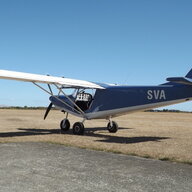continued................
The rest has been very straightforward:
Pretty much the only synchronisation tool you have is adjusting the relative length of those cables.
So I did this:
1. First checked idle stop and idle jet settings as per the LM manual. This is quick and easy, and as noted the idle jet settings were only approximate, so worth doing.
2. With everything in place, I cut and fitted a stop block at the firewall: when the throttles are fully closed, the spare central lever on the throttle bar bottoms on this block. This prevents the carb throttle arms, which are light in construction, from being flexed or bent, upsetting adjustment, if the throttles are closed firmly (as you do when stopping the engine).
3. I reasoned that since the engine spends much of it's time at 75% power or above, this was where I wanted best synchronisation. So I push the throttle knob to fully open, this puts some slack in the cables. I then gradually close the throttle, watching the two throttle arms to see them both start to move off their stops simultaneously.
This required several small cable adjustments in the first 40hrs, but in the 200hrs since, while I run this simple check regularly, I have not had to touch it.
Surprisingly also, given the different cable lengths, the fully closed appears to be pretty much perfectly synchronised too.
And that's it. I inspect all this carefully at service intervals, and lubricate the cables with light oil (I'm not sure about that, but it seems to be working okay in this environment.)


